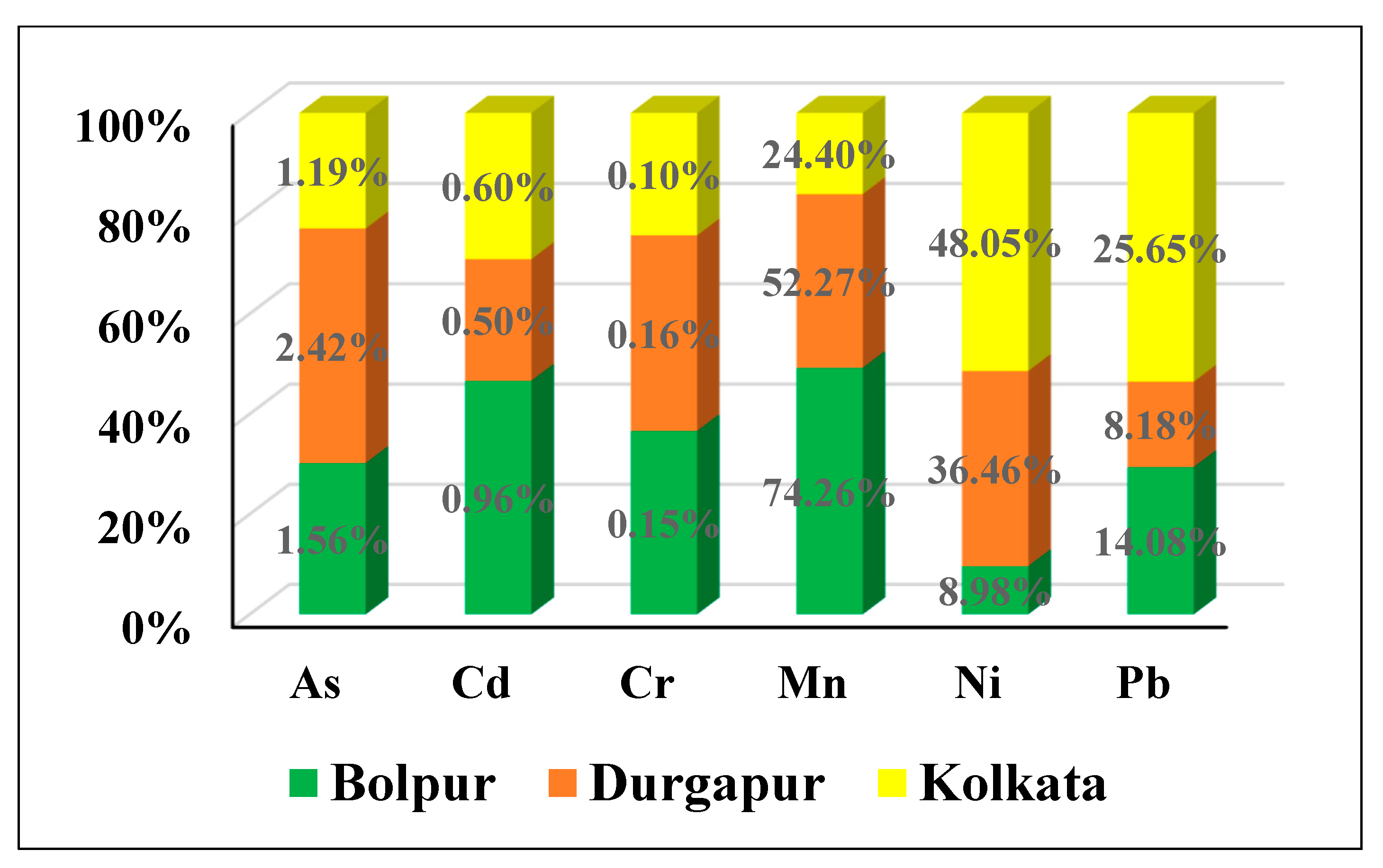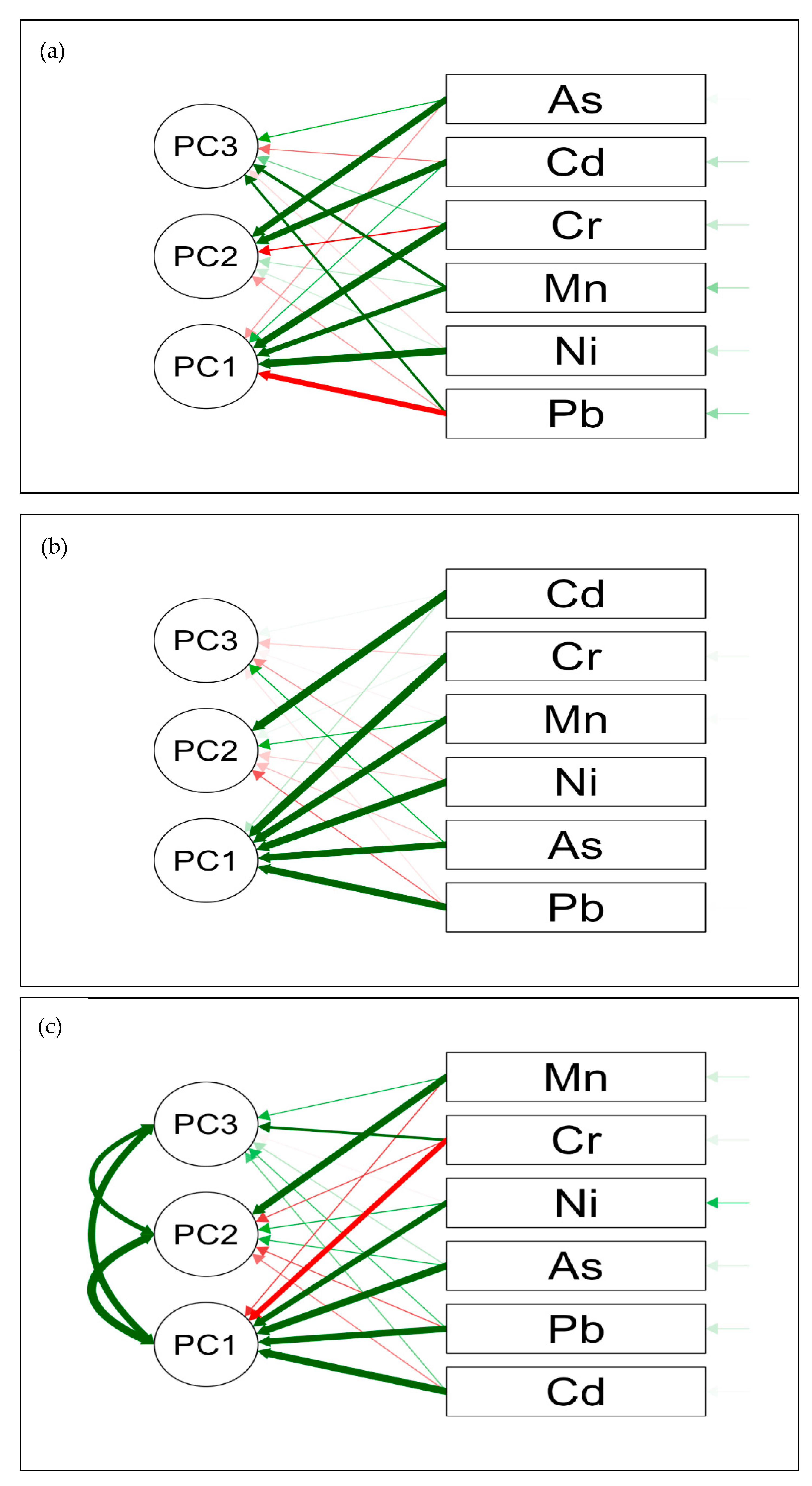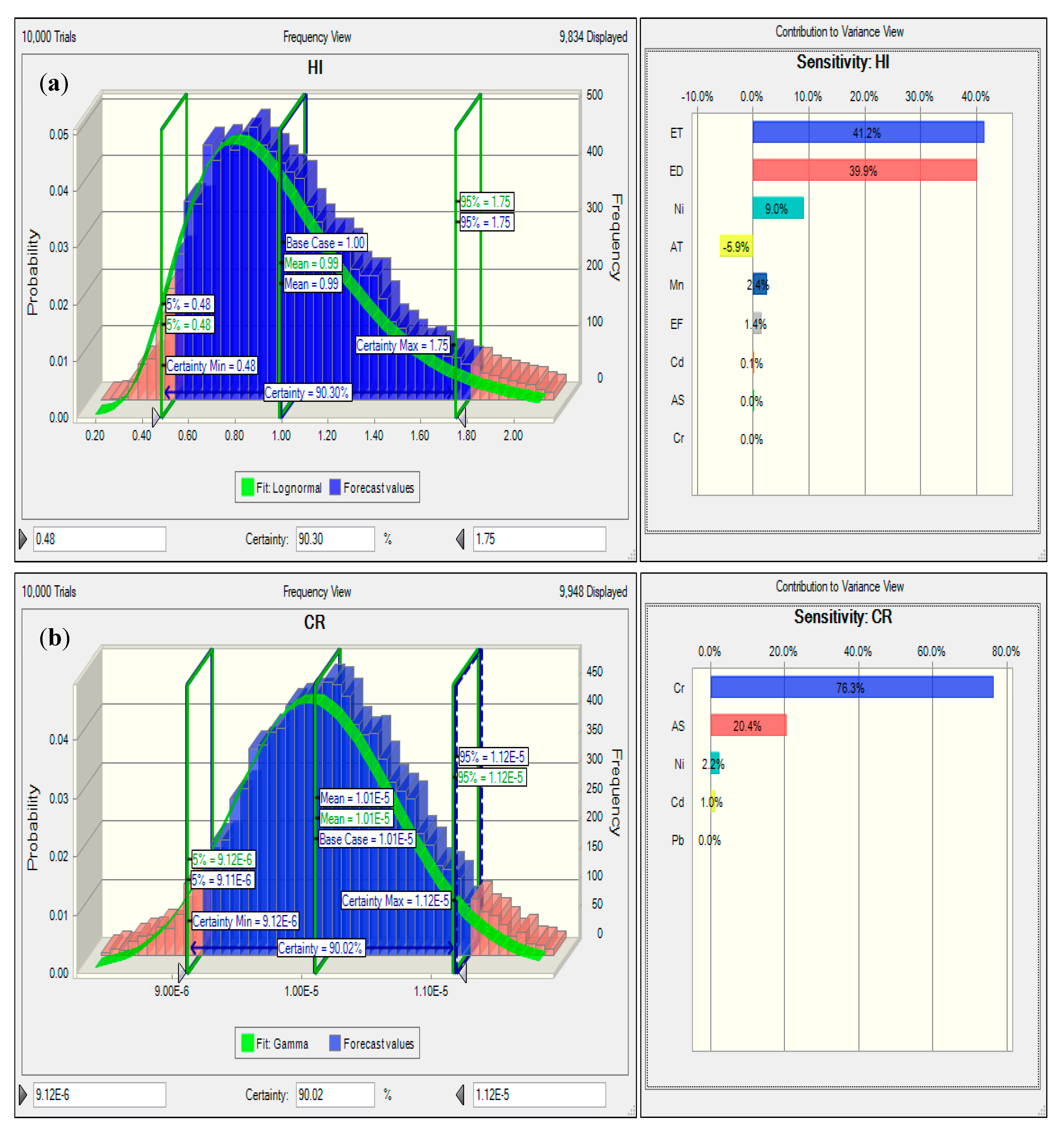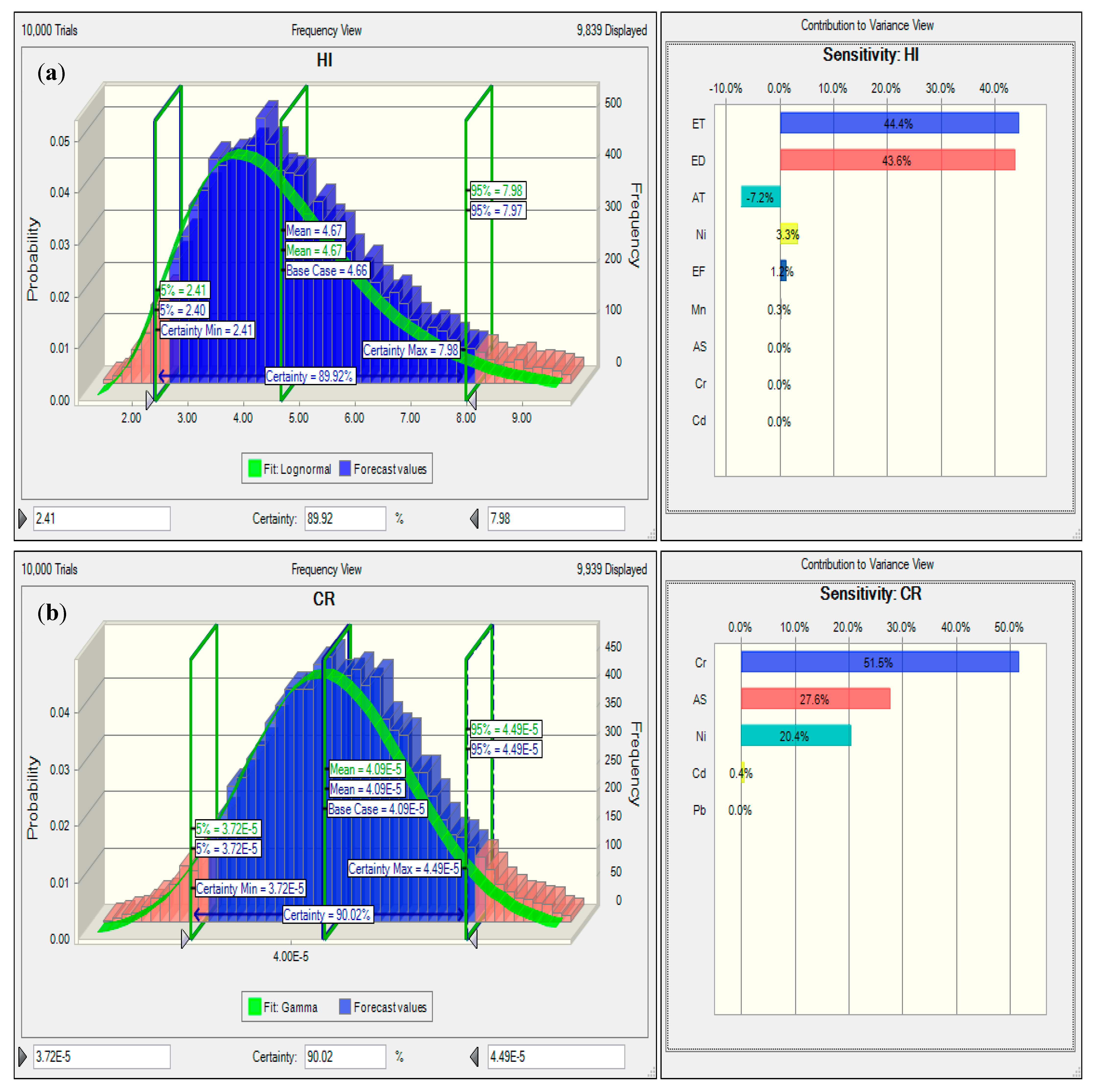A Comparative Study of Heavy Metal Pollution in Ambient Air and the Health Risks Assessment in Industrial, Urban and Semi-Urban Areas of West Bengal, India: An Evaluation of Carcinogenic, Non-Carcinogenic, and Additional Lifetime Cancer Cases
Abstract
:1. Introduction
2. Materials and Methods
2.1. Study Area
2.2. Data Collection
2.3. Analysis of Trace Elements
2.4. Health Risk Assessment
2.5. Statistical Analysis
3. Results and Discussion
3.1. Mass Concentrations of Respirable Suspended Particulate Matter (RSPM)
3.2. Concentration of Heavy Metals (HM)
3.2.1. Relative Distribution of HM
3.2.2. Source Apportionment Study of Metals
3.2.3. Carcinogenic and Non-Carcinogenic Health Risk Assessment
4. Conclusions
Supplementary Materials
Author Contributions
Funding
Data Availability Statement
Acknowledgments
Conflicts of Interest
References
- World Health Organization. Ambient (Outdoor) Air Pollution. Available online: https://www.who.int/news-room/fact-sheets/detail/ambient-(outdoor)-air-quality-and-health (accessed on 2 April 2023).
- Abelsohn, A.; Stieb, D.M. Health effects of outdoor air pollution: Approach to counseling patients using the Air Quality Health Index. Can. Fam. Physician Med. De Fam. Can. 2011, 57, e881–e887. [Google Scholar]
- Brucker, N.; Moro, A.M.; Charão, M.F.; Durgante, J.; Freitas, F.; Baierle, M.; Garcia, S.C. Biomarkers of occupational exposure to air pollution, inflammation and oxidative damage in taxi drivers. Sci. Total Environ. 2013, 463, 884–893. [Google Scholar] [PubMed]
- Maji, K.J.; Dikshit, A.K.; Deshpande, A. Disability-adjusted life years and economic cost assessment of the health effects related to PM 2.5 and PM 10 pollution in Mumbai and Delhi, in India from 1991 to 2015. Environ. Sci. Pollut. Res. 2017, 24, 4709–4730. [Google Scholar]
- Pandey, A.; Brauer, M.; Cropper, M.L.; Balakrishnan, K.; Mathur, P.; Dey, S.; Dandona, L. Health and economic impact of air pollution in the states of India: The Global Burden of Disease Study 2019. Lancet Planet. Health 2021, 5, e25–e38. [Google Scholar]
- Farid, M.U.; Ullah, A.; Ghafoor, A.; Khan, S.N.; Iqbal, M.; Muhayodin, F.; Nasir, A. Air Pollution and Clean Energy: Latest Trends and Future Perspectives; Intechopen: London, UK, 2023. [Google Scholar]
- Perera, F. Pollution from fossil-fuel combustion is the leading environmental threat to global pediatric health and equity: Solutions exist. Int. J. Environ. Res. Public Health 2018, 15, 16. [Google Scholar]
- Haque, M.S.; Singh, R.B. Air pollution and human health in Kolkata, India: A case study. Climate 2017, 5, 77. [Google Scholar] [CrossRef]
- Pandey, M.; Pandey, A.K.; Mishra, A.; Tripathi, B.D. Speciation of carcinogenic and non-carcinogenic metals in respirable suspended particulate matter (PM10) in Varanasi, India. Urban Clim. 2017, 19, 141–154. [Google Scholar]
- Kumar, N.; Kumar, S.; Pandey, S.P. Traffic-Related Air Pollution and Associated Human Health Risk. Macromol. Symp. 2023, 407, 2100486. [Google Scholar] [CrossRef]
- Bhutiani, R.; Kulkarni, D.B.; Khanna, D.R.; Tyagi, V.; Ahamad, F. Spatial and seasonal variations in particulate matter and gaseous pollutants around integrated industrial estate (IIE), SIDCUL, Haridwar: A case study. Environ. Dev. Sustain. 2021, 23, 15619–15638. [Google Scholar]
- Gogikar, P.; Tyagi, B. Assessment of particulate matter variation during 2011–2015 over a tropical station Agra, India. Atmos. Environ. 2016, 147, 11–21. [Google Scholar]
- Chakraborty, B.; Bera, B.; Roy, S.; Adhikary, P.P.; Sengupta, D.; Shit, P.K. Assessment of non-carcinogenic health risk of heavy metal pollution: Evidences from coal mining region of eastern India. Environ. Sci. Pollut. Res. 2021, 28, 47275–47293. [Google Scholar]
- Liu, X.; Ouyang, W.; Shu, Y.; Tian, Y.; Feng, Y.; Zhang, T.; Chen, W. Incorporating bioaccessibility into health risk assessment of heavy metals in particulate matter originated from different sources of atmospheric pollution. Environ. Pollut. 2019, 254, 113113. [Google Scholar] [PubMed]
- Liu, X.; Zhai, Y.; Zhu, Y.; Liu, Y.; Chen, H.; Li, P.; Zeng, G. Mass concentration and health risk assessment of heavy metals in size-segregated airborne particulate matter in Changsha. Sci. Total Environ. 2015, 517, 215–221. [Google Scholar] [PubMed]
- Abdulaziz, M.; Alshehri, A.; Yadav, I.C.; Badri, H. Pollution level and health risk assessment of heavy metals in ambient air and surface dust from Saudi Arabia: A systematic review and meta-analysis. Air Qual. Atmos. Health. 2022, 15, 799–810. [Google Scholar]
- Balali-Mood, M.; Naseri, K.; Tahergorabi, Z.; Khazdair, M.R.; Sadeghi, M. Toxic mechanisms of five heavy metals: Mercury, lead, chromium, cadmium, and arsenic. Front. Pharmaco. 2021, 227, 643972. [Google Scholar]
- Engwa, G.A.; Ferdinand, P.U.; Nwalo, F.N.; Unachukwu, M.N. Mechanism and health effects of heavy metal toxicity in humans. In Poisoning in the Modern World-New Tricks for an Old Dog; Intechopen: London, UK, 2019; Volume 10, pp. 70–90. [Google Scholar]
- IARC Monographs on the Evaluation of Carcinogenic Risks to Humans; Agents Classified by the IARC Monographs; International Agency for Research on Cancer: Lyon, France, 2017; Volume 1–119.
- Guo, L.C.; Lv, Z.; Ma, W.; Xiao, J.; Lin, H.; He, G.; Liu, T. Contribution of heavy metals in PM2.5 to cardiovascular disease mortality risk, a case study in Guangzhou, China. Chemosphere 2022, 297, 134102. [Google Scholar]
- Buonanno, G.; Giovinco, G.; Morawska, L.; Stabile, L. Lung cancer risk of airborne particles for Italian population. Environ. Res. 2015, 142, 443–451. [Google Scholar]
- Kamila, W.; Wioletta, R.K.; Krzysztof, L.; Karolina, K.; Grzegorz, M. Health risk impacts of exposure to airborne metals and benzo (a) pyrene during episodes of high PM10 concentrations in Poland. Biomed. Environ. Sci. 2018, 31, 23–36. [Google Scholar]
- Lamas, G.A.; Ujueta, F.; Navas-Acien, A. Lead and cadmium as cardiovascular risk factors: The burden of proof has been met. J. Am. Heart Assoc. 2021, 10, e018692. [Google Scholar]
- Mahmoud, N.; Al-Shahwani, D.; Al-Thani, H.; Isaifan, R.J. Risk Assessment of the Impact of Heavy Metals in Urban Traffic Dust on Human Health. Atmosphere 2023, 14, 1049. [Google Scholar]
- Olawoyin, R.; Schweitzer, L.; Zhang, K.; Okareh, O.; Slates, K. Index analysis and human health risk model application for evaluating ambient air-heavy metal contamination in Chemical Valley Sarnia. Ecotoxicol. Environ. Safety 2018, 148, 72–81. [Google Scholar]
- Riggin, R.M. Compendium of Methods for the Determination of Toxic Organic Compounds in Ambient Air. Available online: https://www.epa.gov/sites/default/files/2015-07/documents/epa-io-3.1.pdf (accessed on 29 May 2023).
- United States Environmental Protection Agency. Risk Assessment Guidance for Superfund: Pt. A. Human Health Evaluation Manual. Available online: https://www.epa.gov/sites/default/files/2015-09/documents/rags_a.pdf (accessed on 23 May 2023).
- Risk Assessment Guidance for Superfund Volume I: Human Health Evaluation Manual (Part F, Supplemental Guidance for Inhalation Risk Assessment); EPA-540-R-070–002; Office of Superfund Remediation and Technology Innovation, US Environmental Protection Agency: Washington, DC, USA, 2009.
- Pirsaheb, M.; Sharafi, K.; Hopke, P.K.; Hadei, M.; Shahsavani, A. Carcinogenic risks of particulate matter during Middle Eastern dust events and normal days. Atmos. Pollut. Res. 2020, 11, 1566–1571. [Google Scholar]
- Wu, Y.; Lu, B.; Zhu, X.; Wang, A.; Yang, M.; Gu, S.; Chen, L. Seasonal variations, source apportionment, and health risk assessment of heavy metals in PM2. 5 in Ningbo, China. Aerosol Air Qual. Res. 2019, 19, 2083–2092. [Google Scholar] [CrossRef]
- Li, H.; Wang, J.; Wang, Q.G.; Qian, X.; Qian, Y.; Yang, M.; Wang, C. Chemical fractionation of arsenic and heavy metals in fine particle matter and its implications for risk assessment: A case study in Nanjing, China. Atmos. Environ. 2015, 103, 339–346. [Google Scholar]
- Uzoekwe, S.A.; Izah, S.C.; Aigberua, A.O. Environmental and human health risk of heavy metals in atmospheric particulate matter (PM 10) around gas flaring vicinity in Bayelsa State, Nigeria. Toxicol. Environ. Health Sci. 2021, 13, 323–335. [Google Scholar]
- United States Environmental Protection Agency. IRIS Assessments. Available online: https://iris.epa.gov/AtoZ/?list_type=alpha (accessed on 13 September 2023).
- World Health Organization. AirQ+: Software Tool for Health Risk Assessment of Air Pollution. Available online: https://www.who.int/europe/tools-and-toolkits/airq---software-tool-for-health-risk-assessment-of-air-pollution (accessed on 2 May 2023).
- Qu, C.; Sun, K.; Wang, S.; Huang, L.; Bi, J. Monte carlo simulation-based health risk assessment of heavy metal soil pollution: A case study in the Qixia mining area, China. Hum. Ecol. Risk Assess. Int. J. 2012, 18, 733–750. [Google Scholar] [CrossRef]
- Sanaei, F.; Amin, M.M.; Alavijeh, Z.P.; Esfahani, R.A.; Sadeghi, M.; Bandarrig, N.S.; Rezakazemi, M. Health risk assessment of potentially toxic elements intake via food crops consumption: Monte Carlo simulation-based probabilistic and heavy metal pollution index. Environ. Sci. Pollut. Res. 2021, 28, 1479–1490. [Google Scholar]
- Acharjee, A.; Ahmed, Z.; Kumar, P.; Alam, R.; Rahman, M.S.; Simal-Gandara, J. Assessment of the ecological risk from heavy metals in the surface sediment of River Surma, Bangladesh: Coupled approach of Monte Carlo simulation and multi-component statistical analysis. Water 2022, 14, 180. [Google Scholar] [CrossRef]
- Ghosh, S.; Rabha, R.; Chowdhury, M.; Padhy, P.K. Source and chemical species characterization of PM10 and human health risk assessment of semi-urban, urban and industrial areas of West Bengal, India. Chemosphere 2018, 207, 626–636. [Google Scholar]
- Ghosh, B.; De, M.; Rout, T.K.; Padhy, P.K. Study on spatiotemporal distribution and health risk assessment of BTEX in urban ambient air of Kolkata and Howrah, West Bengal, India: Evaluation of carcinogenic, non-carcinogenic and additional leukaemia cases. Atmos. Pollut. Res. 2023, 14, 101878. [Google Scholar]
- Ghosh, B.; Nayek, S.; Padhy, P.K. Effects of Nationwide Lockdown due to COVID-19 on Ambient Air Quality in the State of West Bengal, India. J. Sci. Res. 2023, 15, 183–200. [Google Scholar] [CrossRef]
- Duan, J.C.; Tan, J.H. Atmospheric heavy metals and Arsenic in China: Situation, sources and control policies. Atmos. Environ. 2013, 74, 93–101. [Google Scholar]
- Wu, R.; Yao, F.; Li, X.; Shi, C.; Zang, X.; Shu, X.; Zhang, W. Manganese pollution and its remediation: A review of biological removal and promising combination strategies. Microorganisms 2022, 10, 2411. [Google Scholar] [PubMed]
- Genchi, G.; Carocci, A.; Lauria, G.; Sinicropi, M.S.; Catalano, A. Nickel: Human Health and Environmental Toxicology. Int. J. Environ. Res. Public Health 2020, 17, 679. [Google Scholar] [PubMed]
- IARC Working Group on the Evaluation of Carcinogenic Risks to Humans. Arsenic, Metals, Fibres and Dusts. Lyon (FR): International Agency for Research on Cancer. (IARC Monographs on the Evaluation of Carcinogenic Risks to Humans, No. 100C.) NICKEL AND NICKEL COMPOUNDS. 2012. Available online: https://www.ncbi.nlm.nih.gov/books/NBK304378/ (accessed on 23 May 2023).
- De, A.; Roy, N. Arsenic in Environment-Sources, Implications and Remedies; Intechopen: London, UK, 2023. [Google Scholar]
- Chung, J.Y.; Yu, S.D.; Hong, Y.S. Environmental source of arsenic exposure. J. Prev. Med. Public Health 2014, 47, 253. [Google Scholar] [CrossRef]
- Mmari, A.G.; Hassan, H.A.; Bencs, L. Daytime concentrations of minor and trace elements in atmospheric aerosols at four sampling sites of Dar es Salaam, Tanzania. Air Qual. Atmos. Health 2020, 13, 739–750. [Google Scholar]
- Nayebare, S.R.; Aburizaiza, O.S.; Siddique, A.; Hussain, M.M.; Zeb, J.; Khatib, F.; Khwaja, H.A. Understanding the Sources of Ambient Fine Particulate Matter (PM2. 5) in Jeddah, Saudi Arabia. Atmosphere 2022, 13, 711. [Google Scholar] [CrossRef]
- Dey, S.; Mehta, N.S. Automobile pollution control using catalysis. Resour. Environ. Sustain. 2020, 2, 100006. [Google Scholar]
- Tuccillo, M.E.; Blue, J.; Koplos, J.; Kelly, J.; Wilkin, R.T. Complexities in attributing lead contamination to specific sources in an industrial area of Philadelphia, PA. Heliyon 2023, 9, e15666. [Google Scholar]
- Majumder, A.K.; Al Nayeem, A.; Islam, M.; Akter, M.M.; Carter, W.S. Critical Review of Lead Pollution in Bangladesh. J. Health Pollut. 2021, 11, 210902. [Google Scholar]
- World Health Organization. Manganese and Its Compounds: Environmental Aspects. Available online: https://apps.who.int/iris/bitstream/handle/10665/42992/9241530634.pdf;jsessionid=F4CB6A853E48DA54E0433A746017EE19?sequence=1 (accessed on 23 May 2023).
- Hutton, M. Sources of cadmium in the environment. Ecotoxicol. Environ. Safety 1983, 7, 9–24. [Google Scholar] [CrossRef] [PubMed]
- Junaid, M.; Hashmi, M.Z.; Tang, Y.M.; Malik, R.N.; Pei, D.S. Potential health risk of heavy metals in the leather manufacturing industries in Sialkot, Pakistan. Sci. Rep. 2017, 7, 8848. [Google Scholar] [PubMed]
- Rout, T.K.; Padhy, P.K.; Ebhin, R. Human Exposure Risks of Potentially Toxic Elements in the Dust: A Comparison Between Residential and Commercial Sites of a Coal Mining Town. In Emerging Issues in Environmental Science: Concerns and Management; New Delhi Publishers: New Delhi, India, 2017; pp. 91–100. [Google Scholar]






| Metal | ET (h/Day) | EF (Days/Year) | ED (Years) | AT (h) | RfC (mg/m3) | IUR (m3/μg) |
|---|---|---|---|---|---|---|
| As | 8 | 350 | 24 | 613,200 | 1.50E-05 | 4.30E-03 |
| Cd | 8 | 350 | 24 | 613,200 | 1.00E-05 | 1.80E-03 |
| Cr (VI) | 8 | 350 | 24 | 613,200 | 1.00E-04 | 8.40E-02 |
| Mn | 8 | 350 | 24 | 613,200 | 5.00E-05 | NP |
| Ni | 8 | 350 | 24 | 613,200 | 1.40E-05 | 2.40E-04 |
| Pb | 8 | 350 | 24 | 613,200 | NP | 1.20E-05 |
| Heavy Metal | Bolpur (Mean ± SD) | Durgapur (Mean ± SD) | Kolkata (Mean ± SD) | ANOVA |
|---|---|---|---|---|
| As (ng/m3) | 6.10 ± 0.74 | 26.64 ± 9.75 | 9.51 ± 2.60 | p < 0.05 |
| Cd (ng/m3) | 3.75 ± 1.27 | 5.55 ± 0.69 | 4.78 ± 0.97 | p < 0.05 |
| Cr (ng/m3) | 0.60 ± 0.06 | 1.80 ± 0.62 | 0.83 ± 0.36 | p < 0.05 |
| Mn (ng/m3) | 290.00 ± 56.82 | 575.00 ± 164.04 | 195.00 ± 26.35 | p < 0.05 |
| Ni (ng/m3) | 35.06 ± 8.36 | 401.00 ± 120.31 | 384.00 ± 40.76 | p < 0.05 |
| Pb (ng/m3) | 55.00 ± 7.07 | 90.00 ±22.60 | 205.00 ± 38.28 | p < 0.05 |
| Study Area | Metal | EC | HQ | HI | CR | CRT |
|---|---|---|---|---|---|---|
| Bolpur | As | 6.68E-04 | 0.04 | 2.87E-06 | ||
| Cd | 4.10E-04 | 0.04 | 7.39E-07 | |||
| Cr | 6.52E-05 | 0.00 | 0.99 | 5.48E-06 | 1.01E-05 | |
| Mn | 3.18E-02 | 0.64 | ||||
| Ni | 3.84E-03 | 0.27 | 9.21E-07 | |||
| Pb | 7.53E-03 | 9.04E-08 | ||||
| Durgapur | As | 2.92E-03 | 0.19 | 1.26E-05 | ||
| Cd | 6.08E-04 | 0.06 | 1.09E-06 | |||
| Cr | 1.97E-04 | 0.00 | 4.66 | 1.66E-05 | 4.08E-05 | |
| Mn | 6.30E-02 | 1.26 | ||||
| Ni | 4.39E-02 | 3.14 | 1.05E-05 | |||
| Pb | 1.23E-02 | 1.48E-07 | ||||
| Kolkata | As | 1.04E-03 | 0.07 | 4.48E-06 | ||
| Cd | 5.24E-04 | 0.05 | 9.43E-07 | |||
| Cr | 9.04E-05 | 0.00 | 3.56 | 7.59E-06 | 2.35E-05 | |
| Mn | 2.14E-02 | 0.43 | ||||
| Ni | 4.21E-02 | 3.01 | 1.01E-05 | |||
| Pb | 2.81E-02 | 3.37E-07 | ||||
| USEPA Standard | <1 | <1 | <1.00E-06 | <1.00E-06 |
| Metal | Additional Lifetime Cancer Cases | Additional Lifetime Cancer Cases per 100,000 Person-Years | ||||
|---|---|---|---|---|---|---|
| Bolpur | Durgapur | Kolkata | Bolpur | Durgapur | Kolkata | |
| Ni | 1.47 | 118.86 | 904.00 | 0.02 | 0.22 | 0.21 |
| Cr (VI) | 2.64 | 56.16 | 205.84 | 0.03 | 0.10 | 0.05 |
| As | 1.01 | 31.17 | 88.44 | 0.01 | 0.06 | 0.02 |
Disclaimer/Publisher’s Note: The statements, opinions and data contained in all publications are solely those of the individual author(s) and contributor(s) and not of MDPI and/or the editor(s). MDPI and/or the editor(s) disclaim responsibility for any injury to people or property resulting from any ideas, methods, instructions or products referred to in the content. |
© 2023 by the authors. Licensee MDPI, Basel, Switzerland. This article is an open access article distributed under the terms and conditions of the Creative Commons Attribution (CC BY) license (https://creativecommons.org/licenses/by/4.0/).
Share and Cite
Ghosh, B.; Padhy, P.K.; Niyogi, S.; Patra, P.K.; Hecker, M. A Comparative Study of Heavy Metal Pollution in Ambient Air and the Health Risks Assessment in Industrial, Urban and Semi-Urban Areas of West Bengal, India: An Evaluation of Carcinogenic, Non-Carcinogenic, and Additional Lifetime Cancer Cases. Environments 2023, 10, 190. https://doi.org/10.3390/environments10110190
Ghosh B, Padhy PK, Niyogi S, Patra PK, Hecker M. A Comparative Study of Heavy Metal Pollution in Ambient Air and the Health Risks Assessment in Industrial, Urban and Semi-Urban Areas of West Bengal, India: An Evaluation of Carcinogenic, Non-Carcinogenic, and Additional Lifetime Cancer Cases. Environments. 2023; 10(11):190. https://doi.org/10.3390/environments10110190
Chicago/Turabian StyleGhosh, Buddhadev, Pratap Kumar Padhy, Soumya Niyogi, Pulak Kumar Patra, and Markus Hecker. 2023. "A Comparative Study of Heavy Metal Pollution in Ambient Air and the Health Risks Assessment in Industrial, Urban and Semi-Urban Areas of West Bengal, India: An Evaluation of Carcinogenic, Non-Carcinogenic, and Additional Lifetime Cancer Cases" Environments 10, no. 11: 190. https://doi.org/10.3390/environments10110190
APA StyleGhosh, B., Padhy, P. K., Niyogi, S., Patra, P. K., & Hecker, M. (2023). A Comparative Study of Heavy Metal Pollution in Ambient Air and the Health Risks Assessment in Industrial, Urban and Semi-Urban Areas of West Bengal, India: An Evaluation of Carcinogenic, Non-Carcinogenic, and Additional Lifetime Cancer Cases. Environments, 10(11), 190. https://doi.org/10.3390/environments10110190









